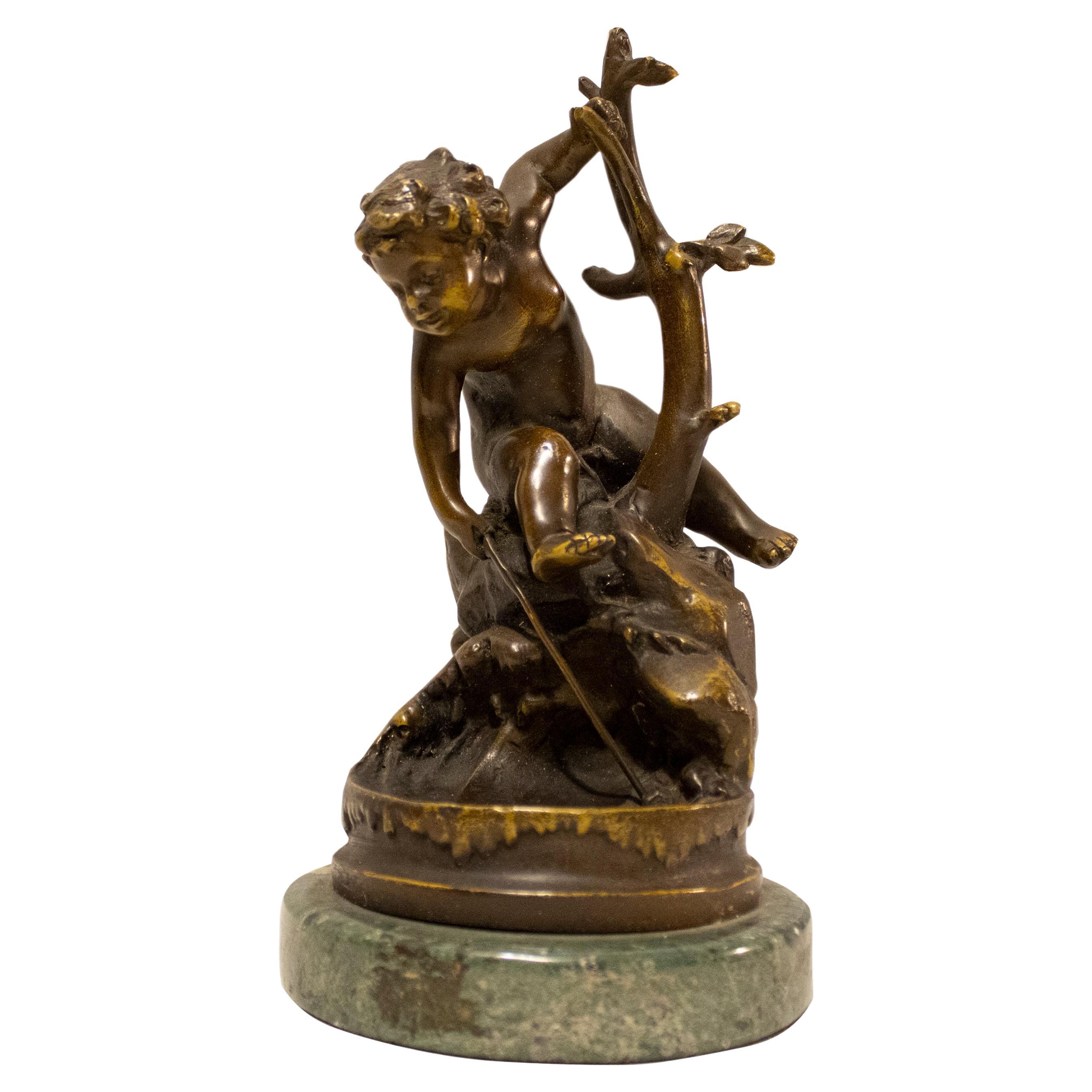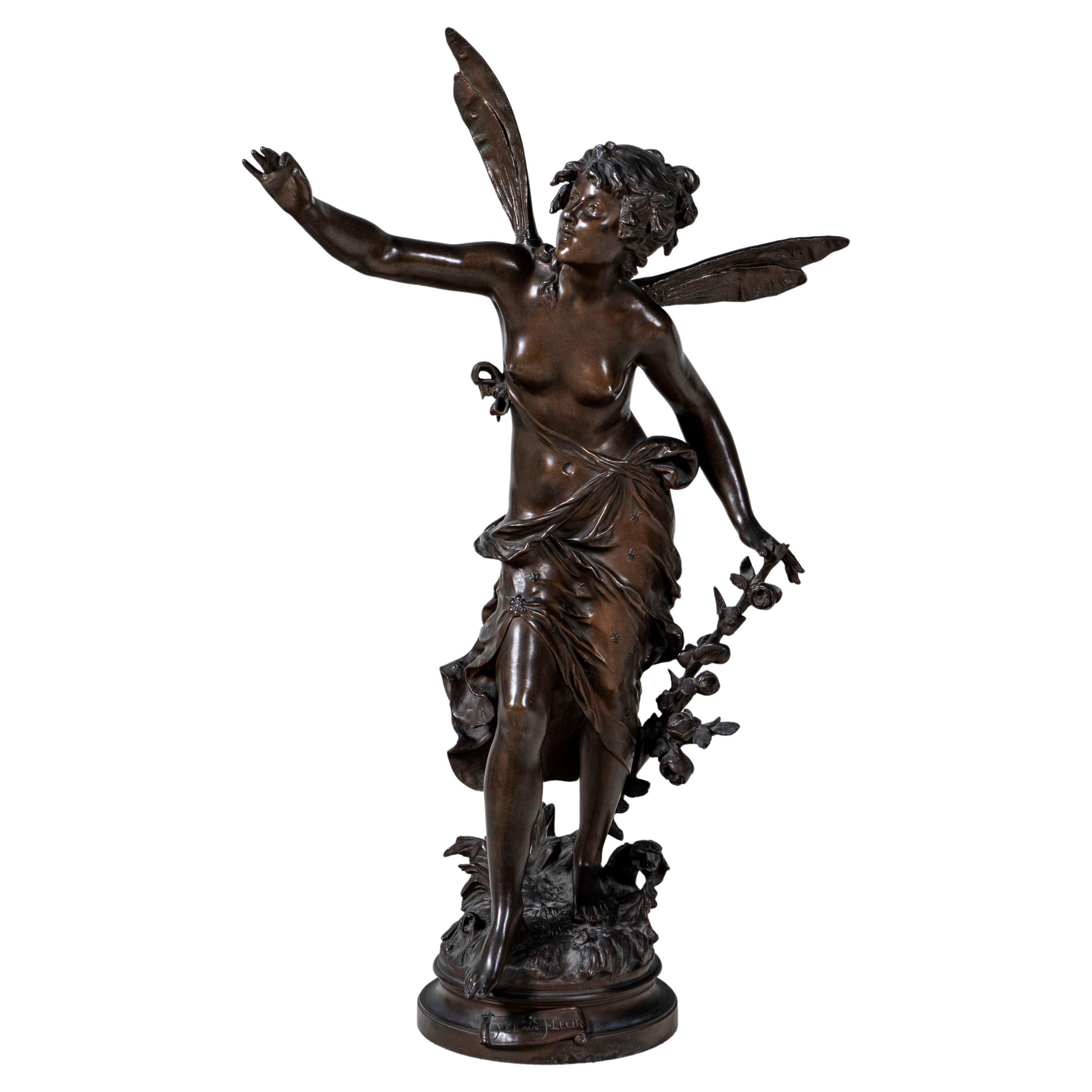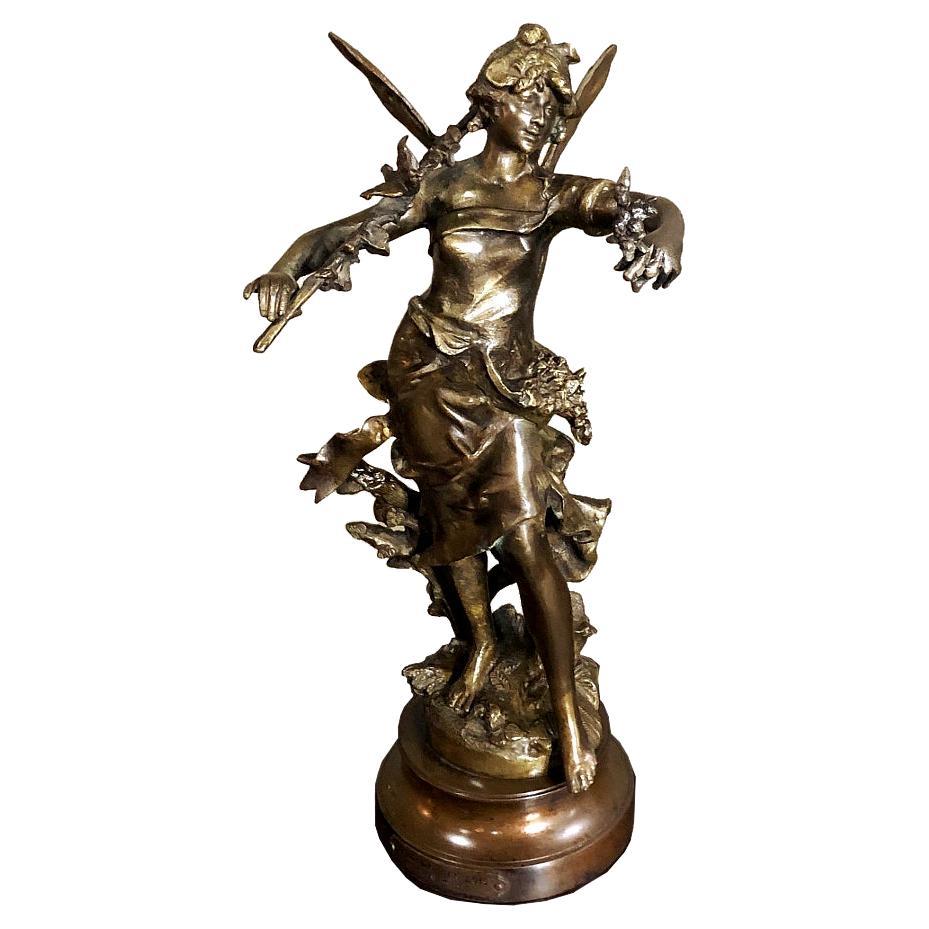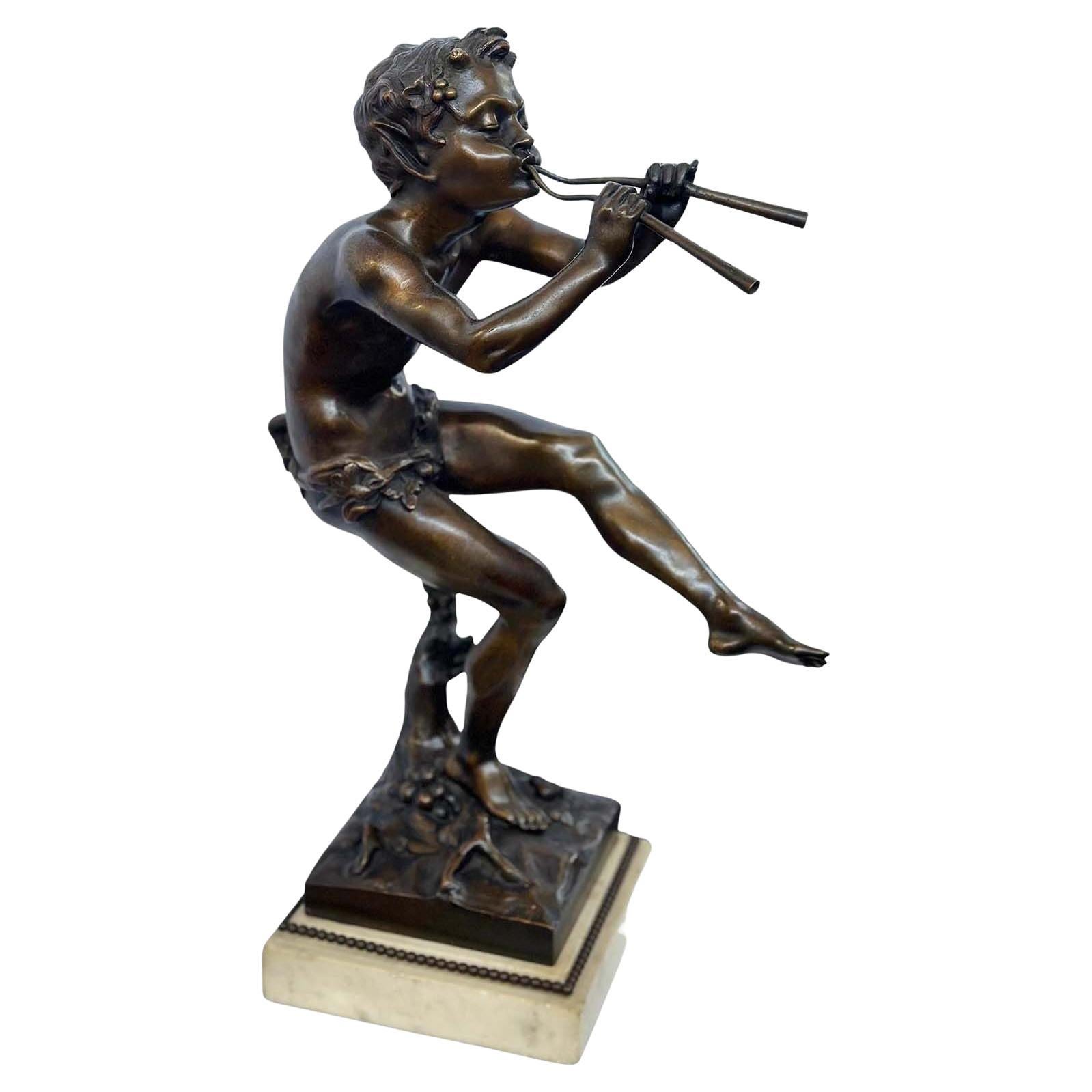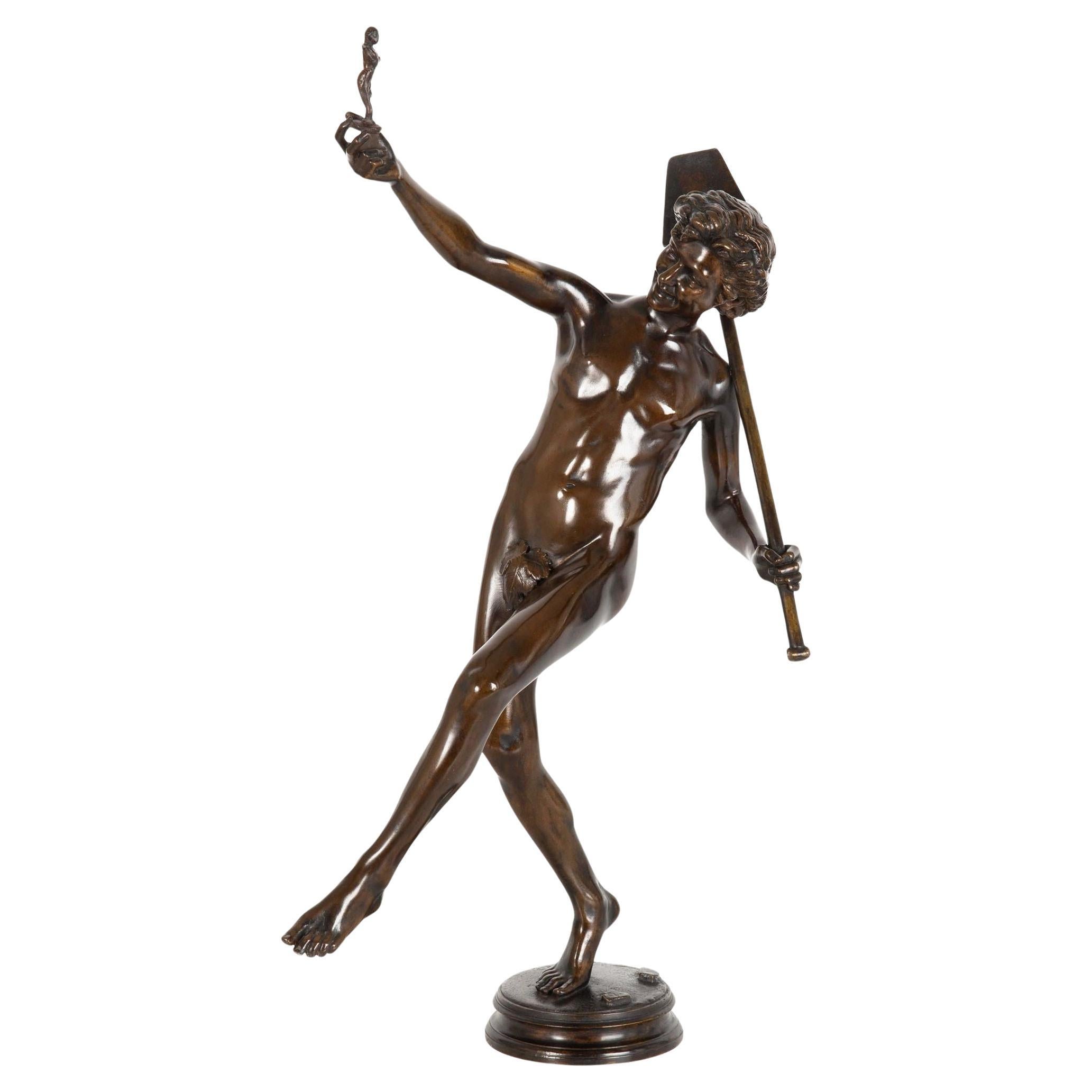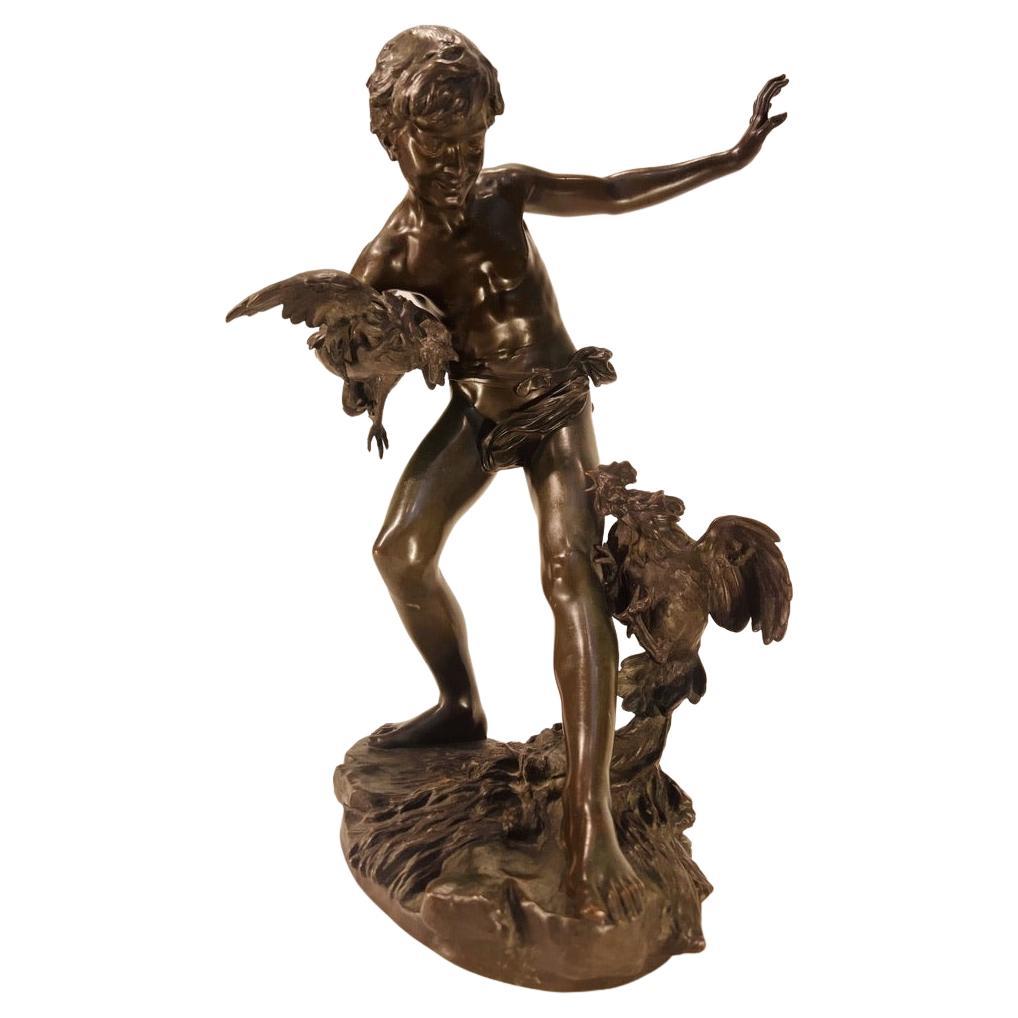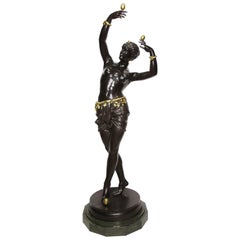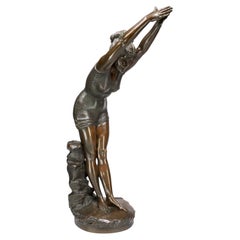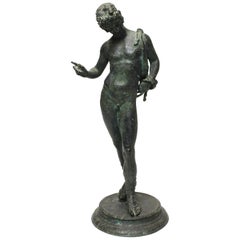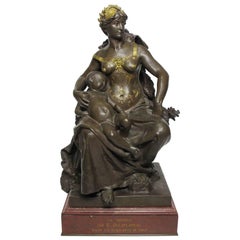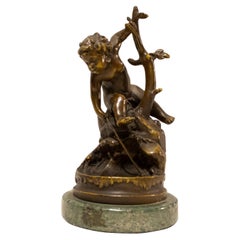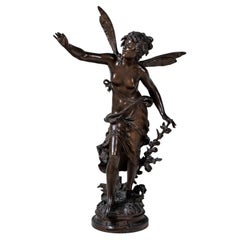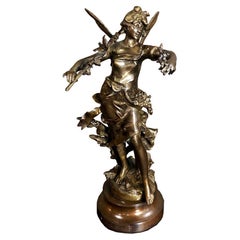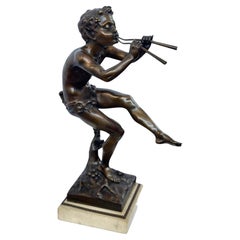Items Similar to French 19th/20th Century Bronze of a Fairy “Lutin des Bois”, After Luca Madrassi
Video Loading
Want more images or videos?
Request additional images or videos from the seller
1 of 22
French 19th/20th Century Bronze of a Fairy “Lutin des Bois”, After Luca Madrassi
$12,450
$18,50032% Off
£9,407.72
£13,979.3532% Off
€10,888.64
€16,179.9132% Off
CA$17,466.74
CA$25,954.5932% Off
A$19,428.02
A$28,868.9532% Off
CHF 10,191.91
CHF 15,144.6132% Off
MX$237,066.01
MX$352,266.7632% Off
NOK 127,921.38
NOK 190,083.9832% Off
SEK 120,550.39
SEK 179,131.1032% Off
DKK 81,279.11
DKK 120,776.1932% Off
About the Item
A Fine French 19th/20th Century Patinated Bronze Figure titled “Lutin des Bois” (Woodland Fairy or Elf) after Luca Madrassi (Italian, 1869-1914). The beautifully executed slender figure of a nude fairy, in a brown patina, wrapped with a loose scarf, standing atop a rock formation with flowers and flanked by a pair of kissing Love doves. Signed 'Madrassi – Paris’ raised on a gilt-bronze circular plinth. A bronze plaque reads "Lutin des Bois - Par Madrassi (Médaille au Salon)". Circa: Paris, 1900.
Luca Madrassi (Italian, 1869-1914) was an Italian-born French artist best known for his bronze Art Nouveau sculptures of mythological, allegorical, and rustic figures. His work was influenced by the famed French illustrator and sculptor Gustave Doré.
Height: 32 3/4 inches (83.2 cm)
Width: 16 inches (40.7 cm)
Depth: 12 3/4 inches (32.4 cm)
Circular Base Diameter: 8 1/2 inches (21.6 cm)
- Creator:Luca Madrassi (Sculptor)
- Dimensions:Height: 32.75 in (83.19 cm)Width: 16 in (40.64 cm)Depth: 12.75 in (32.39 cm)
- Style:Belle Époque (Of the Period)
- Materials and Techniques:
- Place of Origin:
- Period:1900-1909
- Date of Manufacture:Circa: Paris, 1900
- Condition:Refinished. Wear consistent with age and use. Minor fading. A truly beautiful and charming sculpture. Overall current condition is great, the patina has been refreshed and waxed, minor age nicks and wear. Please view all images.
- Seller Location:Los Angeles, CA
- Reference Number:Seller: Ref.: A2721 - Lot 114631stDibs: LU1796236665952
About the Seller
5.0
Vetted Professional Seller
Every seller passes strict standards for authenticity and reliability
Established in 1982
1stDibs seller since 2016
135 sales on 1stDibs
Typical response time: 1 hour
- ShippingRetrieving quote...Shipping from: Los Angeles, CA
- Return Policy
Authenticity Guarantee
In the unlikely event there’s an issue with an item’s authenticity, contact us within 1 year for a full refund. DetailsMoney-Back Guarantee
If your item is not as described, is damaged in transit, or does not arrive, contact us within 7 days for a full refund. Details24-Hour Cancellation
You have a 24-hour grace period in which to reconsider your purchase, with no questions asked.Vetted Professional Sellers
Our world-class sellers must adhere to strict standards for service and quality, maintaining the integrity of our listings.Price-Match Guarantee
If you find that a seller listed the same item for a lower price elsewhere, we’ll match it.Trusted Global Delivery
Our best-in-class carrier network provides specialized shipping options worldwide, including custom delivery.More From This Seller
View AllFrench 19th Century Life-Size Bronze "La Danse des Oeufs" by Gustave-Louis Nast
By Gustave-Louis Nast 1
Located in Los Angeles, CA
A fine and large French 19th century Orientalist style life-size patinated and parcel-gilt bronze sculpture of "La Danse des Oeufs" (The Dance of Golden Eggs) also known as "La Danse...
Category
Antique Late 19th Century French Aesthetic Movement Figurative Sculptures
Materials
Marble, Brass, Bronze
$36,950 Sale Price
43% Off
After Odoardo Tabacchi, Italian 19th Century "La Tuffolina" the Diver
By Odoardo Tabacchi
Located in Los Angeles, CA
After Odoardo Tabacchi (1831-1905) a very fine Italian 19th century patinated bronze figure of "La Tuffolina" (The Diver). The finely cast brown patin...
Category
Antique Late 19th Century Italian Beaux Arts Figurative Sculptures
Materials
Bronze
$9,850 Sale Price
33% Off
Italian 19th Century Grand Tour Bronze Sculpture of Narcissus, after Pompeii
Located in Los Angeles, CA
An Italian 19th century grand tour - Greco Roman bronze sculpture of Narcissus, after the original sculpture excavated in 1862 at Pompeii. The green...
Category
Antique 19th Century Italian Greco Roman Figurative Sculptures
Materials
Bronze
$1,985 Sale Price
42% Off
A French 19th Century Bronze Sculpture Titled "La Sécurité" Eugène Delaplanche
By Eugène Delaplanche
Located in Los Angeles, CA
A very fine French 19th century brown and parcel-gilt patinated bronze sculpture titled "La Sécurité" (The Security - Protection) after a model by Eugène Delaplanche (French, 1836–1891). Depicting a sitting young Maiden in a gilt-decorated armored suit and helmet, a lion skin on her back, holding a resting child on her arm. Raised on Rouge-Royal marble plinth inscribed "La Sécurité - Par E. Delaplanche - Salon des Beaux-Arts de Paris". Signed: E. Delaplanche and stamped with the importer's seal - Alberto Vignes y Ca - Buenos Aires, circa 1890.
Measures: Height: 28 3/4 inches (60.3 cm).
Width: 16 inches (40.7 cm).
Depth: 14 inches (35.6 cm).
Eugène Delaplanche (February 28, 1836 – January 10, 1891) was a French sculptor, born at Belleville (Seine).
He was a pupil of Duret, gained the Prix de Rome in 1864 (spending 1864-67 at the Villa Medici in Rome) and the medal of honor in 1878. His "Messenger of Love" (1874), "Aurora" (1878), and the "Virgin of the Lillies" (1884), are in the Luxembourg. Other works by him are "Music - La Musique" (1878, Paris Opera House), called his masterpiece; "Eve After the Fall" (1869); "Maternal Instruction" (1875, Square of Sainte-Clothilde, Paris). He is also noted for his decorations in relief on vases of Haviland faience. His best work is naturalistic, but at the same time dignified and simple in line and shows sound mastery of technique. He is represented by 15 works in the Glyptothek, Copenhagen and in many other French museums and in churches.
This sculpture of La Sécurité is after his 1884 sculptures...
Category
Antique Late 19th Century French Belle Époque Figurative Sculptures
Materials
Marble, Bronze
$18,450 Sale Price
47% Off
French Art-deco-orientalist Spelter of a Nude Young Maiden, Attributed to Hottot
By Louis Hottot
Located in Los Angeles, CA
An Imposing fine and large French Art-Deco Spelter (Petit-bronze) figure of a standing semi-nude orientalist maiden in a brown patina, attributed to Louis Hottot (French, 1834-1905). The smiling young topless beauty, posing with her arms outstretched, her hair wrapped with a headscarf centred with a green art-glass bead and a scantily scarf tied around her waist, standing barefoot among tropical shrubs and flowers and raised on a circular mottled green marble base. A brass plaque reads "TYPHA", Paris, circa 1900.
Louis Hottot was a French sculpture who mainly specialized in Orientalist female figures and other Orientalist subjects and themes, most of his works were produced in spelter. He exhibited his works at the Paris Salon from 1885 to 1898. Hottot is best known for his Orientalist-themed sculptures, including Almie du Caire, circa 1887 and Fille d'Egypte, circa: 1885. He was a member of the Socie´te´ des Artistes Franc¸ais.
Literature:
Les Bronzes du XIXe Siecle, P. Kjellberg, Les Editions de L'amateur, Paris.
S. Richemond, Les Orientalistes...
Category
Antique Early 1900s French Art Deco Figurative Sculptures
Materials
Marble, Spelter
$24,850 Sale Price
29% Off
An Italian Cast 19th Century Bronze Group Mother & Children Titled "La Tempête"
By Mathurin Moreau
Located in Los Angeles, CA
A Fine Italian Cast 19th Century Bronze Group Titled "La Tempête" (The Tempest) Probably after Mathurin Moreau (French, 1822–1912), Cast by The Alessandro Nelli Foundry in Rome. The ...
Category
Antique Early 1900s Italian Classical Roman Figurative Sculptures
Materials
Marble, Bronze
$15,160 Sale Price
20% Off
You May Also Like
Hand Carved Bronze Sculpture "Playing Boy", France, 20th Century.
Located in Madrid, ES
Sculpture of a boy playing, made of solid hand-carved bronze with a black patina and a circular green marble base. France, 20th century.
Category
20th Century French French Provincial Figurative Sculptures
Materials
Marble, Bronze
Bronze Alloy Sculpture, Signed L. Moreau, France, Late 19th Century
By Louis Auguste Moreau
Located in Buenos Aires, Buenos Aires
Bronze Alloy sculpture "Fée Aux Fleurs", Signed L. Moreau, France, Late 19th Century.
Category
Antique Late 19th Century French Art Nouveau Figurative Sculptures
Materials
Bronze
19th Century Spelter Moreau Statue, Nymphe de Bois
By Louis Auguste Moreau
Located in Dallas, TX
19th Century Spelter Moreau Statue ~ Nymphe de Bois is a charming representation of the mythical wood nymph of ancient legend, rendered by Louis Moreau, one of the amazing family mem...
Category
Antique 1890s French Belle Époque Figurative Sculptures
Materials
Spelter
Bronze Sculpture of a Mythical Faun by Clodion
By Claude Michel Clodion
Located in Los Angeles, CA
Mesmerizing bronze sculpture from the late 19th century of a mythical faun creature playing a flute by Claude Michel Clodion. This character gracefully rests on an elegant marble pl...
Category
Antique Late 19th Century French Figurative Sculptures
Materials
Marble, Bronze
1880s French Antique Bronze Sculpture “Find in Pompeii!” by Hippolyte Moulin
By Thiebaut Freres
Located in Shippensburg, PA
HIPPOLYTE ALEXANDRE JULIEN MOULIN
French, 1832-1884
"Une Trouvaille à Pompéi" (A Find in Pompeii)
Sand-cast and patinated bronze Signed on base "Moulin", sealed with foundry cache...
Category
Antique 19th Century French Romantic Figurative Sculptures
Materials
Bronze
Paul-Romain Chevré bronze 19th.
Located in Rio De Janeiro, RJ
Incredible french bronze "Separating the Cocks" in bronze.
Category
Antique Early 1900s French Rococo Figurative Sculptures
Materials
Bronze
